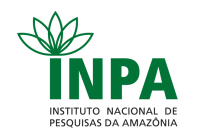Corpo Discente - Egressos
Rafael Sousa Pinto
| Título | ECOLOGIA DA POLINIZAÇÃO DE HUMIRIA BALSAMIFERA (AUBL.) A. ST.- HIL. E SUA IMPORTÂNCIA PARA COMPOSIÇÃO POLÍNICA E PROPRIEDADES FÍSICO-QUÍMICAS DO MEL DA MELIPONICULTURA MARANHENSE | ||||||||||||||||||||||||
| Data da Defesa | 30/11/2020 | ||||||||||||||||||||||||
| Download | Em sigilo | ||||||||||||||||||||||||
Banca
| |||||||||||||||||||||||||
| Palavras-Chaves | Análises físico-químicas; Apis mellifera; Fenologia reprodutiva; Meliponini; Melissopalinologia; Néctar. | ||||||||||||||||||||||||
| Resumo | A espécie Humiria balsamifera tem sido considerada importante fonte de néctar para produção de mel no litoral oriental do Maranhão, mas pouco se sabe a respeito dessa planta, e neste trabalho buscamos estudar aspectos da ecologia da polinização da espécie no Parque Nacional dos Lençóis Maranhenses (PNLM), e compreender qual a sua contribuição para composição do espectro polínico e propriedades do mel de abelhas sem ferrão. Em 2017 foram observadas as fenofases reprodutivas de H. balsamifera, e estas ocorreram em todos os meses do ano. A floração não teve associação com os fatores abióticos, mas a produção de frutos imaturos aumentou no período seco. O principal recurso oferecido aos visitantes florais foi o néctar, procurado por 49 morfo-espécies distribuídos em Hymenoptera, Diptera, Lepidoptera, Coleoptera e Passeriformes. As abelhas tiveram a maior riqueza (17 espécies) e abundância (89% do total). As mais representativas foram as abelhas sociais, e também Xylocopa cearensis e Megalopta amoena, duas espécies solitárias. A atividade das abelhas ocorreu durante todo o ano, e no geral, houve uma correlação positiva entre o aumento das visitas e a intensidade de floração. A análise de pólen do corpo das abelhas revelou 22 tipos polínicos. As espécies sociais foram as que tiveram maior frequência de pólen homoespecífico da planta. A análise da rede de interação mostrou uma estrutura aninhada, indicando a contribuição de H. balsamifera para estabilidade da biodiversidade de abelhas na área. Uma análise mensal do mel de Melipona subnitida e Melipona fasciculata no PNLM mostrou a ocorrência de 56 tipos polínicos em seus méis, tendo M. subnitida maior riqueza, diversidade e uniformidade dos tipos polínicos. Ao realizar uma exclusão dos tipos polínicos pertencentes a espécies que não oferecem néctar floral, verificamos que H. balsamifera foi a principal fonte nectarífera no período, principalmente para M. fasciculata. Outras espécies também se destacaram como Chrysobalanus icaco, Protium heptaphyllum e Coccoloba. Em 2019 foram obtidas 17 amostras de mel de diferentes abelhas (M. fasciculata, M. flavolineata, M. subnitida, Apis mellifera) provenientes das cidades de Morros, Belágua e Barreirinhas. Em todas as amostras o pólen de H. balsamifera esteve presente, mas apenas em três delas ocorreu com frequência superior a 45%. Em outras seis amostras algum outro pólen apareceu como dominante. As análises físico-químicas, microbiológicas e de atividade antioxidante demonstraram boa qualidade dos méis, embora a umidade tenha sido alta para amostras das abelhas sem ferrão, algo normal para essas espécies. As análises de cor, pH, acidez livre, condutividade elétrica, cinzas, fenóis totais, flavonoides totais, atividade antioxidante (DPPH e FRAP) foram suficientes para mostrar pela PCA 75,21% da variância das amostras. Particularmente, os méis das abelhas sem ferrão de Belágua e Morros diferiram das amostras de Barreirinhas e de Apis mellifera, e pareceram evidenciar que nesses méis H. balsamifera predomina sobre outras fontes botânicas. A condutividade elétrica, importante análise para caracterizar a origem botânica e geográfica de mel, indicou que 88,2% dos méis das 3 cidades possuem valores superior a 0,8mS/cm. Não obtivemos resultados conclusivos a respeito da contribuição de H. balsamifera para as propriedades do mel, mas pudemos confirmar que o pólen da espécie ocorre em todas as amostras e é uma fonte importante de néctar. A associação de H. balsamifera com a meliponicultura deve ser valorizada, pois a planta floresce continuamente e as abelhas são vistas o ano todo em suas flores, e ao mesmo tempo que a espécie mantém uma rica fauna de visitantes florais, ela se beneficia destes, já que depende dos animais para realizar sua polinização cruzada. | ||||||||||||||||||||||||
| Abstract | Humiria balsamifera has been considered an important source of nectar for honey production on the eastern coast of Maranhão, but little is known about this plant, and in this work, we seek to study aspects of the pollination ecology of the species in the Lençóis Maranhenses National Park (PNLM), and to understand its contribution to the composition of the pollen spectrum and properties of stingless bee honey. In 2017, the reproductive phenophases of H. balsamifera were observed, and these occurred in all months of the year. Flowering was not associated with abiotic factors, but the production of immature fruits increased in the dry season. The main resource offered to floral visitors was nectar, sought by 49 morpho-species distributed in Hymenoptera, Diptera, Lepidoptera, Coleoptera and Passeriformes. Bees had the highest wealth (17 species) and abundance (89% of the total). The most representative were the social bees, and also Xylocopa cearensis and Megalopta amoena, two solitary species. The activity of the bees occurred throughout the year, and in general, there was a positive correlation between the increase in visits and the intensity of flowering. The pollen analysis of the bees` body revealed 22 pollen types. Social species had the highest frequency of homospecific pollen from the plant. The analysis of the interaction network showed a nested structure, indicating the contribution of H. balsamifera to the stability of bee biodiversity in the area. A monthly analysis of honey from Melipona subnitida and Melipona fasciculata in PNLM showed the occurrence of 56 pollen types in their honeys, with M. subnitida greater richness, diversity and uniformity of pollen types. When making an exclusion of pollen types belonging to species that do not offer floral nectar, we found that H. balsamifera was the main nectariferous source in the period, mainly for M. fasciculata. Other species also stood out like Chrysobalanus icaco, Protium heptaphyllum and Coccoloba. In 2019, 17 honey samples were obtained of different bees (M. fasciculata, M. flavolineata, M. subnitida, Apis mellifera) from the cities of Morros, Belágua and Barreirinhas. In all samples, pollen from H. balsamifera was present, but only in three of them did it occur with a frequency above 45%. In six other samples, some other pollen appeared as dominant. The physical-chemical, microbiological and antioxidant activity analyzes showed good quality of the honeys, although the humidity was high for samples of stingless bees, something normal for these species. The analyzes of color, pH, free acidity, electrical conductivity, ash, total phenols, total flavonoids, antioxidant activity (DPPH and FRAP) were sufficient to show by PCA 75.21% of the sample variance. Particularly, the stingless honeys from Belágua and Morros differed from the samples from Barreirinhas and Apis mellifera, and seemed to show that in these honeys H. balsamifera predominates over other botanical sources. The electrical conductivity, an important analysis to characterize the botanical and geographical origin of honey, indicated that 88.2% of the honeys in the 3 cities have values above 0.8mS/cm. We didn’t obtain conclusive results regarding the contribution of H. balsamifera to the properties of honey, but we were able to confirm that the pollen of the species occurs in all samples and is an important source of nectar. The association of H. balsamifera with meliponiculture must be valued because the plant blooms continuously and bees are seen all year round in its flowers, and while the species maintains a rich fauna of floral visitors, it benefits from them, already which depends on the animals to carry out their cross-pollination. | ||||||||||||||||||||||||
Parceiros

























